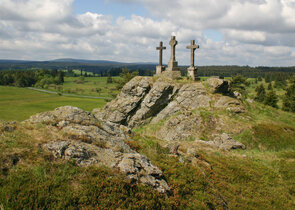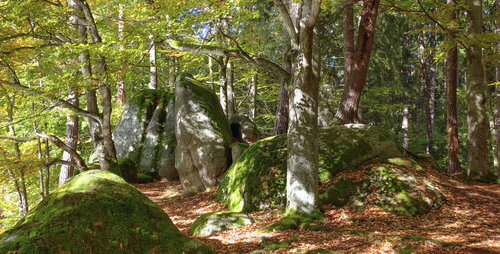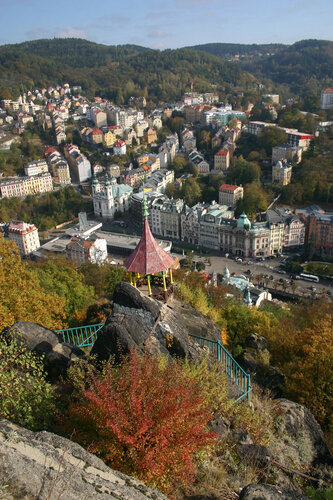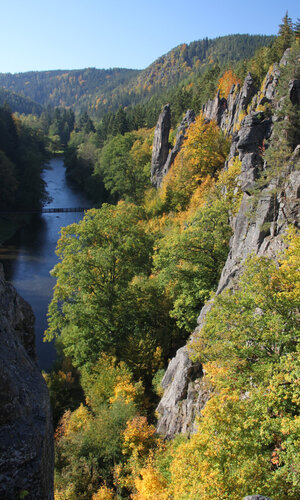Nature Conservation 2025 — 31. 7. 2025 — On Nature in the Czech Republic — Print article in pdf
Fifty Years of the spa Landscape


The Slavkovský les/Slavkov Forest Mts. is a beautiful area with a rich cultural heritage, where humans have been coexisting with nature since ancient times.
Previous generations declared the area between the West Bohemian spas a Protected Landscape Area (PLA); this was in 1974. Today, it feels like a distant history, spanning half a century. What has happened since then? Was it the right thing to do? What has been protected there?
The beginning: the spa towns
The first known impulse to protect the spa landscape is from 1948. It is mentioned in a report by the nature conservationist from the town of Mariánské Lázně/Marienbad, Jaroslav Gotthard (1903–1961). The keen geologist and secondary school teacher persisted in his efforts and, seven years later, submitted a preliminary proposal to the Ministry of Culture recommending the area for protection.
Landscape protection in the West Bohemian Spa Triangle became a prominent theme again at the turn of the 1970s and 1980s. In the northern part of the Slavskovský les/Slavkov Forest Mts., a proposal was made to establish PLA in the Karlovy Vary/Carlsbad region, including designation of protected parks and gardens in the spa town. At the parliamentary level, the Health and Social Committee of the Czech National Council declared protection of the spa area to be necessary and recommended that appropriate measures be taken to this end. The District of Cheb/Eger and of Karlovy Vary/Carlsbad eventually dealt with the issue themselves; the so-called “Petition of the Five Seals” was drawn up. The spa towns of Františkovy Lázně, Jáchymov, Karlovy Vary/Carlsbad, Lázně Kynžvart, and Mariánské Lázně/Marienbad asked the State Monument Care and Nature Conservation based in Prague to establish the Slavkovsjý les/Slavkov Forest Mts. PLA. The spa resorts collectively demanded maximum nature conservation and argued for a harmonious environment in which all the requirements that make comprehensive spa treatment possible were aesthetically balanced. The result was the Decree of the Ministry of Culture of the Czech Republic of 3 May 1974 establishing the Slavkovský les/Slavkov Forest Mts. PLA. This created the first and, to this day, only PLA in the Czech Republic whose mission is to ensure the integrity of natural healing resources.

Granite boulders in the Kynžvart Chateau Park. © Přemysl Tájek
The 1970s: building a solid foundation
In September 1974, the PLA Administration started working. It was based in the town of Mariánské Lázně/Marienbad in the modest conditions of Svatý Jiří/Saint George House and from 1976 in the City House. Within a few years, its five professional employees were surrounded by an unprecedented phenomenon – supporters of the Slavkovský les/Slavkov Forest Mts. It was a team of almost a hundred people of various professions and social groups, who built the then unique Smraďoch (1976), Kladská (1977), and Křížky (1979) educational paths/nature trails. In those days, the magazine Arnika was equally unique, with its first issue published in 1976. The conceptual framework of the 1970s did not have time to grow old. On the contrary, both the educational paths/nature trails in the centre of the Slavkovský les/Slavkov Forest Mts. Forest and Arnika magazine have still been a key tool of communication with the general public to this day.
The beginnings of PLA activities were built largely on voluntary enthusiasm. It was not easy for the Administration staff, who represented a state-established institution. The State Nature Conservancy operated under the Ministry of Culture of the Czech Republic and was based on twenty paragraphs in a vague legal framework from 1956. If they wanted to achieve something, their natural authority and subtle diplomacy was the decisive factor. In today’s business speak, we would say they used the right persuasion techniques. And they were successful. They were able to exclude large areas of wet meadows from drainage at a time when the State strongly favoured the opposite, namely systematic land reclamation. Later, their successors declared these saved meadows and wetlands as Nature Reserves and Nature Monuments. Among many of them, we can mention for example Upolínová louka/Globeflower Meadow (1990), Mokřady pod Vlčkem/Wetlands under the Vlček/Little Wolf Ridge (1995), and Rašeliniště U myslivny/At Gamekeeper’s Lodge Peatbog (2006). After almost forty years, the purpose of their work was further fulfilled in 2012, when the wetlands of the Slavkovský les/Slavkov Forest Mts. achieved international recognition. The vast area within the central part of the Slavkovský les/Slavkov Forest Mts. and the adjacent Tepelská vrchovina/Teplá Highlands in the PLA was included in the list of the world’s outstanding wetland areas, i.e. Wetlands of International Importance, protected by the Ramsar Convention under the designation “Springs and mires of Slavkov Forest”.

The Jelení Skok/Red Deer’s Jump view point above the spa of Karlovy Vary/Carlsbad. In the valley by the Teplá River, the Hot Spring Colonnade, with the beech forests of the recently declared Karlův hvozd/Charles Deep Forest Nature Reserve in the background. © Přemysl Tájek
The 1980s: collaboration with the Ministry of Health and the burden of pollution
1981 was an important milestone in the history of the PLA as an institution; an agreement with the Czech Inspectorate of Spas and Mineral Springs on cooperation and mutual representation was concluded. This was valuable interaction with the Ministry of Health of the Czech Republic. It was a significant act, one that was far from just a formal procedure. For more than a decade, it fundamentally strengthened the State Nature Conservancy’s decision-making position in the Slavkovský les/Slavkov Forest Mts. in the most essential aspect: the harmonious connection between living and non-living nature, and linking the local biota with the spa and its natural healing resources. Specifically, in the infiltration area of the Mariánské Lázně/Marienbad spring structure, which stretches from the southern edge to the centre of the Slavkovský les/Slavkov Forest Mts., as well as in its northern part, which influences the formation of the Karlovy Vary/Carlsbad thermal spring.
However, the 1980s also saw the culmination of a serious and now largely forgotten reminder; the mountain range there is one of the first places in the Czech Republic where the effects of air pollution were documented. Thousands of hectares of forest stands were damaged by air pollution, mainly from industrial and mining enterprises around the Slavkovský les/Slavkov Forest Mts. An example is the Kladská Forest Management Unit (1983–1993), where all the stands were classified as special purpose forests, in the subcategory of air pollution damage. With the exception of the summit of Lesný, total dieback never occurred; the Slavkovský les/Slavkov Forest Mts. did not suffer the fate of the Krušné hory/Ore Mountains. Good rainfall balance at that time and the fact that the Norway spruce (Picea abies) is a native woody plant species in the upper parts of the Slavkovský les/Slavkov Forest Mts. probably had a favourable influence. Forestry operations supported by the PLA Administration never ceased to strive for natural regeneration in forest growths. This was the case even during the peak of the air pollution disaster, when the so-called replacement tree species, such as the Blue spruce (Picea pungens), were used in the neighbouring Krušné hory/Ore Mountains. Thanks to the greening of air pollution sources, especially desulphurisation in coal-fired power units, air pollution chemical concentrations have been on a downward trend since the late 1980s. The Slavkovský les/Slavkov Forest Mts. coped with the very difficult period and the mutual respect of foresters and conservationists at that time clearly contributed to the preservation of native woody plant/tree species, even in the highest parts of the Slavkovský les/Slavkov Forest.

Granite rocks in Svatošské skály/Svatoš Rocks National Nature Monument. Together with the surrounding predominantly beech forests, they are part of the Kaňon Ohře/Ohře River Canyon Bird Area, i.e. Special Area of Conservation under EU Birds Directive. © Přemysl Tájek
The 1990s: a time of major changes
Large-scale drainage of waterlogged soils has had a major impact on the Slavkovský les/Slavkov Forest Mts. landscape. And often there were no sound reasons for it, unless we are referring to the implementation of the state plan. With the turn of the century, these activities ceased and water retention in the landscape began to be promoted. This was a positive change, although in many places it came too late; for example, it failed to prevent the disappearance of the Black grouse (Lyrurus tetrix) from their historical lekking sites. Arable land heavily enriched with nitrogen fertilisers was also disappearing. The change was triggered by the new economic situation in agriculture. It was a significant qualitative shift; potato fields on the plateaus in the Slavkovský les/Slavkov Forest Mts. were replaced by grassy pastures. Permanent grassland may be perceived as a monotonous habitat, but in the conditions of the Slavkovský les/Slavkov Forest Mts. it is now the best matrix for agricultural landscape management with the shallow genesis of mineral springs.
Every era leaves its mark, and it is no different in the history of the Slavkovský les/Slavkov Forest Mts. PLA. The first twenty years of its existence established a very solid foundation for the dynamic changes that occurred after 1992. At that time, the revolutionary new Act on Nature Conservation and Landscape Protection strengthened both species and territorial protection. This was a fundamental change, which brought the social importance of nature conservation into a whole new ‘orbit’. In contrast to the past, the status of the PLA Administration also changed – it began to function as a true Public/State Administrtaion authority. It was granted new powers, undertook new activities requiring relevant professional support, and finally received much-needed staff reinforcement. Finally, after years of theoretical discussions, it was possible to start a systematic declaration of small-size Specially Protected Areas, such as Údolí Teplé/Teplá River Valley Nature Reserve (1992), Prameniště Teplé(Teplá River Soring Nature Reserve (1993), and Podhorní vrch Nature Reserve (1998). The first broader scientific studies of natural sites were also launched, which enriched existing knowledge of the Slavkovský les/Slavkov Forest Mts. On the other hand, enthusiastic volunteering started disappearing, giving way to a more transactional ‘give and take’ approach.
Turn of the century: active landscape management and care of visitors
The turn of the century marked a significant shift in the protection, conservation and management of the Slavkovský les/Slavkov Forest Mts. The PLA Administration got a new tool –management of selected sites. It had space for targeted activities, the financial means to do so, and was making full use of it. These were a wide range of special measures to stabilise and improve the quality of local natural habitats, which are now being implemented. Sheep grazing returned to serpentinite sites. Wet meadows that had lain fallow for decades were regularly mowed. Water runoff slowed down in the Kladská Peatbogs and drainage channels created during the military forestry period by ammunition were sealed off. Mineral springs that had not been maintained for years were cleaned and covered. New lines of trees were established in the open landscape and European silver fir (Abies alba) trees planted in forests beyond the scope of the forest management plan. The flower meadows, which had not been maintained for over forty years, was freed from continuous encroachment. Small water bodies were built, often extensive systems of pools in the source areas of key catchments/river basins. The impact on the nature of the Slavkovský les/Slavkov Forest Mts. became apparent quite early on. A textbook example is the stabilisation of the flagship species of wet meadows, the Marsh fritillary (Euphydryas aurinia); this is an endangered species at the pan-European level and within the Czech Republic, being currently found only in the western part of Bohemia.
For the guests of the world-famous local spa resorts, the Slavkovský les/Slavkov Forest Mts. provide a natural therapeutic backdrop. For the PLA Administration, this means an exceptional mission, one that comes with responsibility. In addition to the spa forests, the traditional hunting village of Kladská is a common destination for spa guests, for which the PLA Administration continuously maintains the necessary infrastructure. The number of visitors to Kladská and its surroundings has grown exponentially over the years, especially after 2000. Therefore, in 2010, the boardwalk leading around the lake to Kladská Peatbogs National Nature Reserve was extended and enhanced with new stops. The credit for this goes to the foresters, a permanent and reliable partner of the PLA Administration. Cooperation with Forests of the Czech Republic, state enterprise, continued in 2012, when the Slavkovský les/Slavkov Forest Mts. House of Nature was opened at Kladská. A visitor centre was built where guests can find both relaxation and information in a well-equipped facility and can use a two-kilometre-long circuit on boardwalks leading to the inaccessible wetland of the Kladská peatbogs. This is a key destination point in the Slavkovský les/ Slavkov Forest Mts., which requires a perfect partnership between State Nature Conservancy authorities, forest management body, and the spa town to operate. A positive fact is that Kladská is not the only site where similar cooperation has been established, all to the benefit of nature and its visitors.
The vision of the spa towns has been implemented
It has been fifty years since the spa towns in western Bohemia wished to protect the spa landscape. Today, they can be fully satisfied. Their wish has come true and their shared vision has been significantly elevated; in 2017, a new Agreement on Mutual Cooperation was concluded with the Ministry of Health of the Czech Republic and the Czech Inspectorate of Spas and Mineral Springs. It has defined new cooperation between the State Nature Conservancy authorities and the needs of spa towns, at the level of Public/State Administration, joint projects, and provision of data and information. In July 2021, the Slavkovský les/Slavkov Forest Mts. landscape was inscribed on the UNESCO World Heritage List. For the first time, the local landscape is officially designated as therapeutic. Karlovy Vary/Carlsbad and Mariánské Lázně/Marientbad, together with Františkovy Lázně, are included in the prestigious list of eleven European spa towns in seven European countries under the title of the Great Spa Towns of Europe. In the declaration itself, emphasis was placed on the spa landscape context. Therefore, buffer zones were established to appropriately cover the forests, which reasonably circle around Mariánské Lázně/Marienbad and Karlovy Vary/Carlsbad. Targeted cooperation between the State Nature Conservancy and National Heritage authorities has also enabled designation of the Kladská Landscape Conservation Zone (2020). Thus, protection of the landscape scenery/character in the central part of the Slavkovský les/Slavkov Forest Mts. has been significantly strengthened.
A significant event in recent times has been obtaining climatic spa status for Mariánské Lázně/Marienbad (2023). The climatic spa now covers the core part of the PLA, as well as the UNESCO World Heritage Site buffer zone and the Kladská Landscape Conservation Zone. It is another example of the uniqueness of the nature in the Slavkovský les/Slavkov Forest Mts. and the interplay of landscape values and the interests of individual ministries/sectors. With a bit of exaggeration, it can be said that the Slavkovský les/Slavkov Forest Mts. PLA is a recognised healing resource. What more could a visitor and nature conservationist ask for!
There is a saying that nature can do without us, but we cannot do without nature. That is why, even in times of prosperity, we should be able to recognise the small links and not succumb to “ostrich syndrome”. This is what those who started nature conservation activities fifty years ago did. They were consistent, did not stay entrenched and, instead, offered appropriate solutions. Compared to today, they had a modest background, but despite that, they succeeded and deserve deep respect for it.
Let us hope that the next fifty years will be at least as kind to the Slavkovský les/Slavkov Forest Mts. as the past years have been. ■
- - - -
Cover photo: Serpentine outcrops in the Křížky/Little Crosses National Nature Reserve, with the Upolínová louka/Globeflower Meadow below the Křížky/Little Crosses and the plateau of the Slavkovský les/Slavkov Forest Mts. behind them. On the horizon, the highest peaks in the area – Mt. Lysina (on the left) and Mt. Lesný. © Přemysl Tájek

